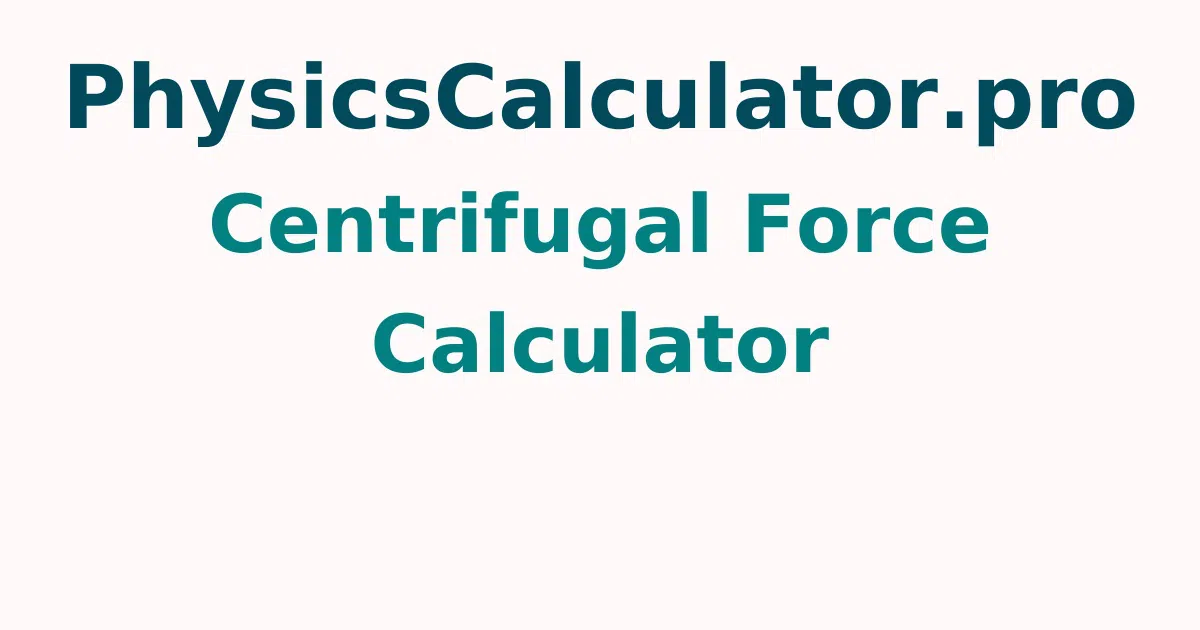Centrifugal Force Calculator
The Centrifugal Force Calculator is used to determine the amount of force applied on a rotating body depending on its mass, velocity, and rotational radius. To receive the centrifugal force, angular velocity, and angular acceleration values in the output section, simply enter the inputs in the available fields and press the calculate button.
What is Centrifugal Force?
The inertia force that emerges in each rotating object is known as centrifugal force. It's only required in a rotating reference frame, or when we're looking at the system from the perspective of a moving object.
Newton's first law states that if no force is applied to an object, it will move in a straight line. A centrifugal force, acting outwards from the centre of rotation, is required for rotation to occur.
Centrifugal Force Formula
The following are the centrifugal force formulas
- F = mv²/r
- v = ωr
- ω = v/r
- a = F/m
- r = mv²/F
- m = Fr/v²
Where, F = centrifugal force, m = mass of the object, v = velocity, r = radius, ω = angular velocity, a = centrifugal acceleration
How to Compute Centrifugal Force?
The steps for calculating angular acceleration and centrifugal force are described below
- Step 1: Calculate the object's mass, velocity, and radius.
- Step 2: Multiply the object mass by the squared velocity.
- Step 3: To get the centrifugal force, divide the product by the radius.
- Step 4: To determine the angular velocity, divide the velocity by the radius.
- Step 5: To calculate the centrifugal acceleration, divide the force by the mass of the object.
For more concepts check out physicscalculatorpro.com to get quick answers by using this free tool.
How to use Centrifugal Force Calculator?
The following is the procedure how to use the centrifugal force calculator
- Step 1: Input the unknown value's mass, radius, tangential velocity and x in the appropriate input fields.
- Step 2: To acquire the result, click the "Calculate the Unknown" button.
- Step 3: Finally, the output field will show the angular velocity, force, centrifugal acceleration.
Centrifugal Force Examples
Question 1: An object with a mass of 3 kg is moving at a speed of 7.2 m/s in a circular direction. The circular walkway has a radius of 3.5 metres. What are the centrifugal force and acceleration?
Solution:
Given: Mass of the object m = 3 kgs
Velocity v = 7.2 m/s
Radius r = 3.5 m
Centrifugal force F = mv²/r
F = (3 x 7.2²)/3.5
= (3 x 51.84)/3.5
= 155.52/3.5
= 44.43
Angular velocity ω = v/r
= 7.2 / 3.5
= 2.05
Centrifugal Acceleration a = F/m
a = 44.43/3
= 14.81
As a result, the centrifugal force on the item is 44.43 N, the angular velocity is 2.05 rad/s, and the centrifugal acceleration is 14.81 m/ sec^2.
FAQs on Centrifugal Force Calculator
1. What is a centrifugal force with an example?
When viewed from a rotating frame of reference, centrifugal force acts on any object travelling in a circular path. For Example: At the poles and on the equator, the weight of an object is different.
2. What is centrifugal load, and how does it work?
The consequence of a centrifugal load is that the entire model spins around an axis you designate. Instead, the comparable forces that would arise from angular rotation and/or angular acceleration are calculated and applied to each element's nodes.
3. What is the principle of centrifugal force?
The centrifugal force is a fictitious force that occurs when a particle moves in a circular route and has the same magnitude and dimensions as the centripetal force but points in the opposite direction.
4. Is it true that gravity is a centrifugal force?
An object's gravity force is the centrifugal force perceived as pointing downwards towards the hull in the spinning frame of reference.
5. How do you remember centripetal and centrifugal?
The centripetal force attracts items to the centre. The word centrifugal has an F in it. Keep in mind that centrifugal forces cause items to move far away. Objects are drawn closer together by centripetal forces, which are spelt with a P.
